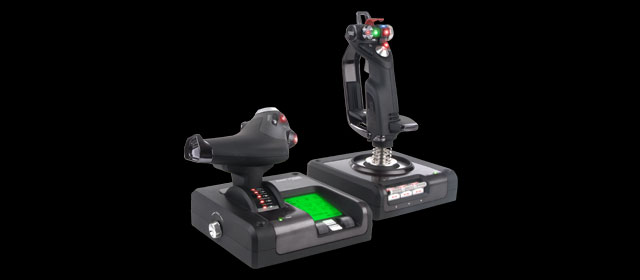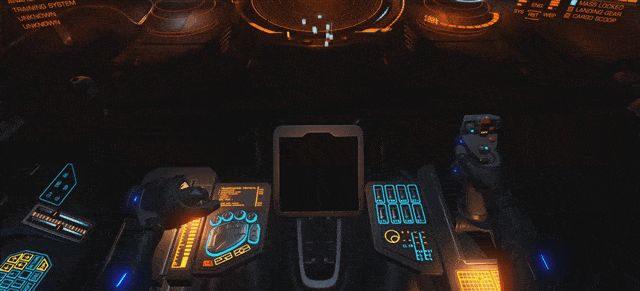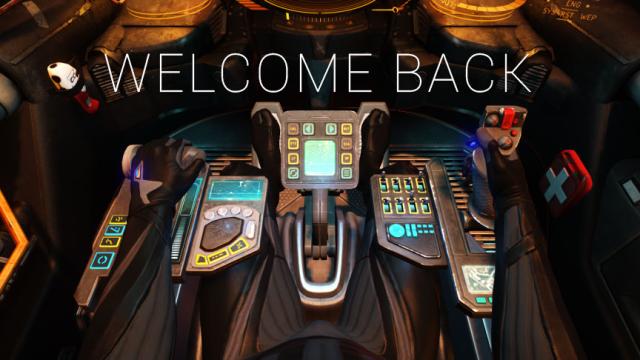It’s a word that’s synonymous with video games, but let’s be real: outside of some niche genres the joystick has been dead and buried as a viable control method for well over a decade now.
Note that this post is talking about the traditional definition of a joystick: a single stick that you grab, with the buttons on it. The analogue stick, thumbstick and nub may have evolved from the joystick, but as I’ll get to, they serve a different master.
Once a mainstay of video game controls on every home computing platform under the sun (and even the earliest consoles), the joystick thrived throughout the 80s and 90s, first because it was the only way you could play a decent action game on PC (since a keyboard and mouse sucked), and later, even following the introduction of control pads, they stuck around because many of the biggest and most popular PC series were space shooters and flight sims, for which a joystick was basically a requirement.
Around the turn of the millennium, though, things changed. People stopped playing flight sims. The Wing Commander and X-Wing games dried up. In 2005 Microsoft’s latest home console would change the landscape of PC gaming forever, by giving the platform a third standard peripheral, the Xbox 360 controller, which even a decade later remains ubiquitous.
The joystick was done for. Sure, a few specialist manufacturers clung on, building hardcore systems for hardcore enthusiasts of hardcore flight sims, but the days of every PC gamer having a joystick on their desk were long gone.
I say were long gone because, as I look down at my desk, I see something sitting there that I haven’t seen in years. I talk to friends who say the same things: “wow, I dug out my old joystick the other day”, or “hahaha guess what I just spent $US200 on a H.O.T.A.S.”
There’s a joystick renaissance going on, and it’s a beautiful thing to behold.

The funny thing is, it’s not because the joystick itself has somehow been dramatically reinvented. They might look a little cooler than they did in 1994, and be made of better parts, but they’re still a stick you move around and press some buttons on. There’s not the drastic difference you’d see comparing, say, a SNES controller and a DualShock 4.
No, what’s bringing the joystick back is a return of the games that were once its lifeblood. There may not be any new X-Wing games on the horizon, but there are still two very big, new space games you can play in 2015. Elite: Dangerous is the latest instalment in a series that is now 30 years old, while Star Citizen is being made by Chris “Wing Commander” Roberts. The former is now formally and officially “released”, while the latter, despite being a work in progress, is still continuously playable for those who have backed its colossal crowd-funding scheme.
And they’re just the front-runners. The imminent arrival of virtual reality headsets are sure to usher in a whole new flood of space shooters and flight sims, like EVE: Valkyrie and Enemy Starfighter, as the pairing of a virtual set of eyes to a stationary cockpit scenario is the easiest (and most practical) use of the new technology.
This is good news. Not just for people who sell joysticks, but for people who make video games and, even more importantly, people who play them.
A control pad, or a mouse and keyboard, are devices designed to function. You press buttons, a game responds, that’s it. But a joystick, thanks to its design and its similarities with actual military and commercial hardware, is so much more than just an input device.
It’s a gateway inside the game world, an immersive tool more effective than any visual flair or trick of sound design. If I play Elite: Dangerous with a control pad, I’m playing a video game. If I play it using my own pro flight system (a fancy joystick with a throttle system), though, saying it’s a “video game” suddenly doesn’t feel like I’m doing it justice. Pushing the throttle forwards on my desk as my craft lurches into space just feels real, as does using a joystick that looks (and, with its array of buttons, functions) dangerously like the one my in-game avatar is holding.
This is of course nothing new. It’s why hardcore driving fans use wheels, or why people still speak fondly of Steel Battalion, despite it being a terrible video game, purely because it shipped with an enormously wonderful custom controller, which turned a terrible video game into something that was a lot of fun.

So, joysticks are coming back! Before we get too carried away, though, let’s be clear: just because they’re back from the dead (or, at least, the fringes) doesn’t mean they will be everywhere. You won’t be seeing seven different varieties of them on GameStop shelves, or be playing Arkham Knight or the next Assassin’s Creed with one.
It’s also a comeback constrained by cash money; while 20 years ago the most popular joysticks might have been respectable $US30 peripherals, it doesn’t take long looking through the forums of games like Elite and Star Citizen to see that the sticks people are picking up now cost a lot more than that (a decent H.O.T.A.S. system will set you back around $US150).
But the fact people are looking through those forums at all, asking for advice on profiles and settings and even which joystick to buy, is satisfying enough. So long as it’s got the right games to play, a joystick isn’t just a way to play games, it’s a way to make them better.

Comments
34 responses to “The Joystick Is Back. Long Live The Joystick.”
Tac2 or GTFO
Greatest joystick on the Commadore 128D/Amiga, primary reason metal shaft, plastic joystick = snapped joystick, usually on the Tac2 it was the contacts or buttons that went first
GTFO with your trashy Tac2 trash. Star Cursor or nothing. Best non-analog stick ever made.
http://www.lemon64.com/forum/viewtopic.php?t=20508&sid=bdb666a1f370687f16ff622f868de284
Oh hell yeah. The SC was an amazing bit of kit.
Best joystick primarily because they were unbreakable. If you ever opened one up you’d see how overengineered they were.
Unbreakable? Let me introduce you to my little friend: Kick Off 2
How about some recommendations for a good stick to buy?
Also, when is Enemy Starfighter coming out. 😀
I love my Saitec X55 Rhino, its a thing of beauty, and feels amazing… a little expensive but do not regret my buy, after some setup it runs amazing in ED and DCS, as well as Flight sim X and star citizen.
I use the same. I was looking at the Thrustmaster Warthog, but a friend has one, and while amazing – it’s really purpose built just for the A-10. X-55 is a lot more flexible.
The Twist feature does seem to make the X55 a better choice. $330 is a chunk of change, but I guess it would last pretty much forever.
Anything decent at the lower end? Like a Thrustmaster or something?
I was using a Logitech Extreme 3D for a while, which is great – but I wanted a HOTAS solution. Unfortunately it seems the X55 (in my research anyway) is the only reasonable option if you want more than an entry level stick, but don’t want to go $500+ bananas on a Thrustmaster Warthog.
Which don’t get me wrong, the X55 is brilliant, and worth every cent. Love it. There’s just not a lot of other options in the midrange. If anyone else has any other input it might help.
EDIT: pccasegear has the X55 for $299, btw. That’s where I got mine from.
Picked up the Logitech Extreme 3D for just over $30 bucks on sale at DS. Am very happy with it.
HOTAS is just too far out of my budget.
I’ve had my Ex3D for about 5 years, and it’s still great. It’s stood up to a beating.
The Thrustmaster T-16000M is a lot of peoples (including mine – as I use it) suggestion at the lower end of the scale. Picked up mine for $59. Good solution for the short term while I wait for the official HOTAS coming from CIG (Star Citizen).
Plus one for the T16k. I picked up one to use with Elite, and I love it. I have pondered the idea of a separate throttle for it, or even a dual-stick setup… but honestly just the stick on its own is more than adequate, I’m really happy with it.
Another +1 for the T16K, great joystick. Like you have pondered a 2nd joystick or throttle, but came across the delta throttle http://www.deltathrottle.com which looks really cool.
If only I had a 3D printer 🙁
I got mine from Umart for $255 on sale.
@ynefel might be worth waiting around see if it drops or get it on special again.
I love my X52 pro, but the switch placement is weird – stick hand should never let go, so i have to reach over with my left hand to do landing gear.
X55 switch placement looks a lot better, plus split throttle for flight sims…
Maybe I’ll get an X55 when I build a cockpit later in the year.
Selfie stick.
EDIT: Apparently I didn’t read the article properly.
X, Wing, Tie Fighter, X Wing vs. Tie Fighter and X Wing alliance all showed that the joystick is very much a required peripheral for the computer.
Thankyou GOG.
Pfft ‘Joystick’?? How bloody old are you, Luke?? In the 21st century, we use the HOTAS!! :p
Not everyone can afford them even if we want them.
I know, the pricing is pretty ridiculous.
Must be time for that TIE Fighter reboot then…
It’s always time for a TIE Fighter reboot!
“a decent H.O.T.A.S. system will set you back around $US150”.
I payed like $70-80 for my logitech and its decent….
Best cheap entry point is the Thrustmaster T.Flight HOTAS X. $75 and it has 12 buttons plus a throttle-based yaw or stick twist yaw.
Been rocking the X-55 since Christmas, would never go back! So gorram good!
Oh look at YOU. :-p
On tonight?
Potentially, if I can break away from everything else 😛
Atari’s 2600 is the best joystick. One Button To Rule Them All!
Thrustmaster HOTAS X – picked mine up a week or two ago for $68 at Umart.
Entry level HOTAS stick but does the job well.
Makes playing Elite and Star Citizen a whole different experience from mouse & keyboard.
I picked up a Saitek X52 Pro off of Gumtree for $50, damn good investment, makes playing Elite:Dangerous a much more satisfying and immersive experience.